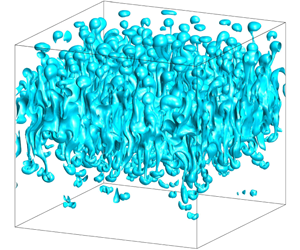Article contents
Numerical study of double-diffusive sedimentation in thermally stratified fluid
Published online by Cambridge University Press: 27 April 2020
Abstract

We conduct Eulerian–Lagrangian simulations to study double-diffusive sedimentation in stratified flows. The results show the pattern of double-diffusive sedimentation and the transition to the pattern of Rayleigh–Taylor instability when the size of particles increases. In cases of double-diffusive sedimentation, our simulation results show little variation in the temperature-to-particle flux ratio among cases with various particle sizes and initial concentrations, which is consistent with previous theoretical derivations and experimental observations. The energy budget is analysed to show that the settling enhancement is a result of the thermal effect combined with shear dissipation and that the thermal contribution decreases as the size increases. Based on the balance of the energy budget, velocity scaling was derived for the quasi-steady state in the thermally controlled region, which can be used to characterize the plumes’ final velocity of double-diffusive sedimentation. Moreover, adopting some values from the simulation results yields a velocity criterion with which to distinguish different sedimentation patterns. Finally, we investigate changes in the particle-laden plumes below the region of the apparent temperature gradient at which secondary instabilities occur in the form of significant horizontal flow motion. We show that the resulting initial shift of the dominant modes can be approximated with the existing theoretical analysis of collective instabilities for salt fingers. A simple scaling argument for the change in the total cross-sectional area of particle-laden plumes is presented, which is then used to scale the resulting enhanced sedimentation.
- Type
- JFM Papers
- Information
- Copyright
- © The Author(s), 2020. Published by Cambridge University Press
References
- 6
- Cited by




